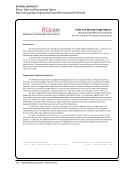180 · Representative Documents: Workflows
Michigan State University
How to Accession Electronic records to the Spartan Archive Storage Vault
DRAFT
3/15/12
12. Accession files on hard drive or media into the Digital Shelf using Duke Data Accessioner.
• Open Duke Data Accessioner
• Under “Adapters” menu, select DROID and JHOVE adapters.
• Under “Metadata Managers, select Duke PREMIS.
• Enter your name, the accession number assigned, and the collection number.
• Click the button labeled “Accession Directory” and select the accession’s record group
folder in the Storage Vault.
• Click the disk icon and select the drive or media to be accessioned.
• Ensure that a logical name is entered into the Disk Name text box. For example, if the
accession includes several CDs, the first might be named CD-‐-‐-‐1, the second CD-‐-‐-‐2, and so
on.
• Click the “Disk Label” tab. Transcribe any appropriate label text into the box.
• Click on the “Additional Notes” tab and enter any pertinent information that a processor
might need to know about the original disk or the data. For example, file formats found
of the preserved files. Any restrictions could be noted here as well.
• Click the “Migrate” button. This will create a folder labeled with the accession number in
the record group folder. The new folder will contain a folder labeled with the assigned
disk name containing two files: (1) the contents of the media and (2) an XML file that
includes checksums, creation dates, and other metadata for the files on the media.
• Verify the creation of the new folder and files in the record group folder.
• Repeat the steps above for each hard drive or media in the accession. Each addition to
the accession will result in a new folder containing the contents of that media.
Additional XML markup will concatenate in the original XML file.
• For more on using the Duke Data Accessioner, refer to the Duke University Data
Accessioner guide, http://www.duke.edu/~ses44/downloads/guide.pdf.
13. Remove media. Place all media related to the accession in a folder/envelope labeled with date
of accession and accession number and store in the electronic records accession file drawer.
14. What to do with hard drive? (TBD)
15. Complete accession record in Archivists’ Toolkit
• Title – Unit ID, Unit Name
• Extent—in GB
• Summary (if needed)
• Date range
• Location—R Drive and/or Digital Accessions Drawer (for original media)
• Retention Rule (“Permanent”)
• Description of records. Include information about transfer mechanism, original media,
and any viruses in original transfer, if applicable.
• Link to external document (transmittal form). Use inventory field only if needed
Michigan State University
How to Accession Electronic records to the Spartan Archive Storage Vault
DRAFT
3/15/12
12. Accession files on hard drive or media into the Digital Shelf using Duke Data Accessioner.
• Open Duke Data Accessioner
• Under “Adapters” menu, select DROID and JHOVE adapters.
• Under “Metadata Managers, select Duke PREMIS.
• Enter your name, the accession number assigned, and the collection number.
• Click the button labeled “Accession Directory” and select the accession’s record group
folder in the Storage Vault.
• Click the disk icon and select the drive or media to be accessioned.
• Ensure that a logical name is entered into the Disk Name text box. For example, if the
accession includes several CDs, the first might be named CD-‐-‐-‐1, the second CD-‐-‐-‐2, and so
on.
• Click the “Disk Label” tab. Transcribe any appropriate label text into the box.
• Click on the “Additional Notes” tab and enter any pertinent information that a processor
might need to know about the original disk or the data. For example, file formats found
of the preserved files. Any restrictions could be noted here as well.
• Click the “Migrate” button. This will create a folder labeled with the accession number in
the record group folder. The new folder will contain a folder labeled with the assigned
disk name containing two files: (1) the contents of the media and (2) an XML file that
includes checksums, creation dates, and other metadata for the files on the media.
• Verify the creation of the new folder and files in the record group folder.
• Repeat the steps above for each hard drive or media in the accession. Each addition to
the accession will result in a new folder containing the contents of that media.
Additional XML markup will concatenate in the original XML file.
• For more on using the Duke Data Accessioner, refer to the Duke University Data
Accessioner guide, http://www.duke.edu/~ses44/downloads/guide.pdf.
13. Remove media. Place all media related to the accession in a folder/envelope labeled with date
of accession and accession number and store in the electronic records accession file drawer.
14. What to do with hard drive? (TBD)
15. Complete accession record in Archivists’ Toolkit
• Title – Unit ID, Unit Name
• Extent—in GB
• Summary (if needed)
• Date range
• Location—R Drive and/or Digital Accessions Drawer (for original media)
• Retention Rule (“Permanent”)
• Description of records. Include information about transfer mechanism, original media,
and any viruses in original transfer, if applicable.
• Link to external document (transmittal form). Use inventory field only if needed










































































































































































































